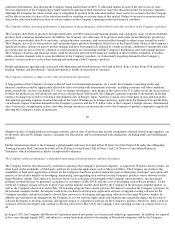Apple 2002 Annual Report Download - page 35
Download and view the complete annual report
Please find page 35 of the 2002 Apple annual report below. You can navigate through the pages in the report by either clicking on the pages listed below, or by using the keyword search tool below to find specific information within the annual report.
Such conditions have resulted in higher premium costs, higher policy deductibles, and lower coverage limits. For some risks, because of cost
and/or availability, the
42
Company does not have insurance coverage. For these reasons, the Company is retaining a greater portion of its insurable risks than it has in
the past at relatively greater cost.
The Company is exposed to credit risk on its accounts receivables. This risk is heightened as economic conditions worsen.
The Company distributes its products through third-party computer resellers and retailers and directly to certain educational institutions and
commercial customers. A substantial majority of the Company's outstanding trade receivables are not covered by collateral or credit insurance.
The Company also has non-trade receivables from certain of its manufacturing vendors resulting from the sale by the Company of raw material
components to these manufacturing vendors who manufacture sub-
assemblies or assemble final products for the Company. While the Company
has procedures in place to monitor and limit exposure to credit risk on its trade and non-trade receivables, there can be assurance that such
procedures will be effective in limiting its credit risk and avoiding losses. Additionally, if the global economy and regional economies fail to
improve or continue to deteriorate, it becomes more likely that the Company will incur a material loss or losses as a result of the weakening
financial condition of one or more of its customers or manufacturing vendors.
The market value of the Company's non-current debt and equity investments is subject to significant volatility.
The Company holds minority investments in several public companies with a combined fair market value of approximately $39 million as of
September 28, 2002. These investments are in publicly traded companies whose share prices are subject to significant volatility. The Company
has categorized its investments in these companies as available-for-sale requiring the investments be carried at fair value, with unrealized gains
and losses, net of taxes, reported as a component of accumulated other comprehensive income. The Company recognizes an impairment charge
to earnings when it is judged an investment has experienced a decline in value that is other-than-temporary. The Company has recognized
material impairment charges related to its non-current debt and equity investments twice in the last two fiscal years.
The Company is subject to risks associated with environmental regulations.
Production and marketing of products in certain states and countries may subject the Company to environmental and other regulations
including, in some instances, the requirement that the Company provide consumers with the ability to return to the Company product at the end
of its useful life, and place responsibility for environmentally safe disposal or recycling with the Company. Although the Company does not
anticipate any material adverse effects in the future based on the nature of its operations and the thrust of such laws, there is no assurance that
such existing laws or future laws will not have a material adverse effect on the Company.
The parliament of the European Union is working on finalizing the Waste Electrical and Electronic Equipment Directive (the Directive). The
Directive makes producers of electrical goods, including personal computers, financially responsible for the collection, recycling, and safe
disposal of past and future products. The Directive must now be approved and implemented by individual European Union governments by
June 2004, while the producers' financial obligations are scheduled to start June 2005. The Company's potential liability resulting from the
Directive related to past sales of its products and expenses associated with future sales of its product may be substantial. However, because it is
likely that specific laws, regulations, and enforcement policies will vary significantly between individual European member states, it is not
currently possible to estimate the Company's existing liability or future expenses resulting from the Directive. As the European Union and its
individual member states clarify specific requirements and policies with respect to the Directive, the Company will continue to assess its
potential financial impact. Similar legislation may be enacted in other geographies, including federal and state legislation in the United States,
the cumulative impact of which could be significant.
43
Business interruptions could adversely affect the Company's future operating results.
The Company's major business operations are subject to interruption by earthquake, fire, power shortages, terrorist attacks and other hostile
acts, labor disputes, and other events beyond its control. The majority of the Company's research and development activities, its corporate
headquarters, and other critical business operations, including certain major components suppliers and manufacturing vendors, are located near
major seismic faults. The Company does not carry earthquake insurance for direct quake-related losses. The Company's operating results and
financial condition could be materially adversely affected in the event of a major earthquake or other natural or manmade disaster.
Unanticipated changes in the Company's tax rates could affect its future results.
























